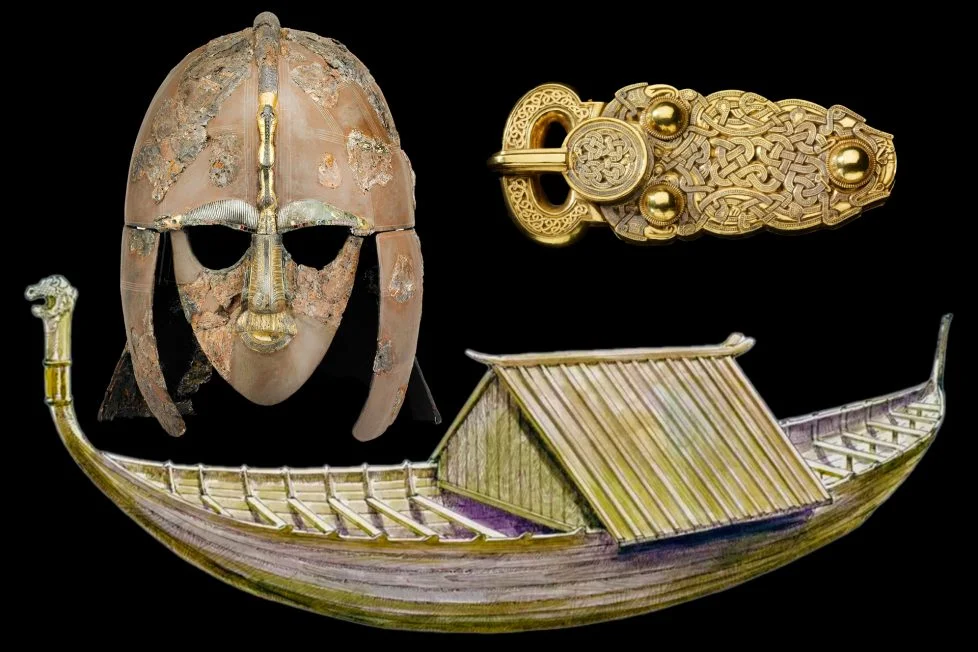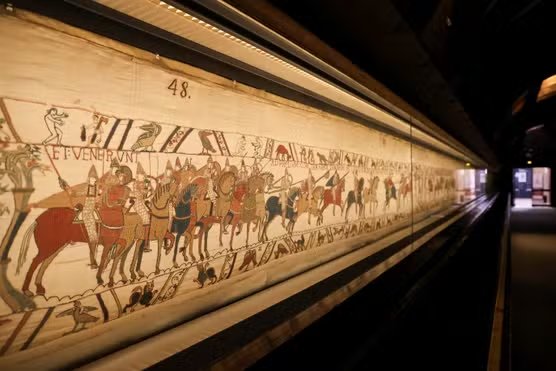Anglo-Saxons, Vikings, and Norman conquest
How Britain changed from Roman to Norman times — including the Anglo-Saxons, Vikings, and the Norman Conquest.
The Anglo-Saxons
When the Roman army left Britain in AD 410 to protect other parts of the empire, they never returned. Soon after, tribes from northern Europe — the Jutes, Angles, and Saxons — invaded Britain. Their languages became the foundation of modern English.
By around AD 600, the Anglo-Saxons had created several kingdoms across Britain, mainly in what is now England. One of their kings was buried at Sutton Hoo, in Suffolk, with treasure and armour placed inside a ship covered by earth.

However, the west of Britain, including most of today’s Wales and Scotland, stayed free from Anglo-Saxon control.
At first, the Anglo-Saxons were not Christians. But missionaries arrived to spread Christianity. Missionaries from Ireland preached in the north — including St Patrick, the patron saint of Ireland, and St Columba, who built a monastery on Iona, an island near Scotland. In the south, St Augustine came from Rome and became the first Archbishop of Canterbury.
The Vikings
The Vikings came from Denmark, Norway, and Sweden. Their first visit to Britain was in AD 789, when they raided coastal towns and took goods and slaves. Later, they began to stay and build communities, especially in eastern England and Scotland.
King Alfred the Great united the Anglo-Saxon kingdoms and defeated the Vikings. Still, many Vikings remained in the east and north of England, an area known as the Danelaw. Many town names there, such as Grimsby and Scunthorpe, come from Viking words. Over time, the Vikings mixed with locals and many became Christians.
Afterwards, Anglo-Saxon kings ruled England again, except for a short time when Danish kings took over. The first Danish king was Cnut (also called Canute).
In the north, Viking attacks encouraged people to unite under one king — Kenneth MacAlpin. Around this time, the name “Scotland” began to be used.
The Norman Conquest
In 1066, William, Duke of Normandy (from northern France), invaded England. He defeated Harold, the Saxon king, at the Battle of Hastings. Harold was killed, and William became king. He is known as William the Conqueror. The battle is remembered in the Bayeux Tapestry, an embroidered artwork that still exists in France today.

The Norman Conquest was the last successful foreign invasion of England. It brought major changes to the government and society. The language of the new rulers, Norman French, influenced the English language.
The Normans also conquered parts of Wales, though the Welsh slowly regained land. They fought with the Scots along the border but never invaded Scotland.
William ordered a detailed survey of England. It listed all towns, villages, people, landowners, and animals. This record, called the Domesday Book, still exists today and shows what life was like after the Norman Conquest.
Key Points
- Romans left Britain in AD 410.
- Northern European tribes (Jutes, Angles, Saxons) invaded Britain.
- Anglo-Saxon kingdoms formed by AD 600, mainly in England.
- Sutton Hoo was the burial site of an Anglo-Saxon king.
- Wales and Scotland stayed outside Anglo-Saxon control.
- Christianity spread through missionaries like St Patrick, St Columba, and St Augustine.
- Vikings came from Denmark, Norway, and Sweden, starting raids in AD 789.
- Vikings settled in the east and north (the Danelaw).
- King Alfred the Great united Anglo-Saxon kingdoms and defeated the Vikings.
- Danish kings, including Cnut, later ruled for a short time.
- Kenneth MacAlpin united Scotland under one king.
- The Norman invasion of 1066 was led by William the Conqueror.
- Harold was defeated and killed at the Battle of Hastings.
- The Bayeux Tapestry tells the story of the Norman victory.
- Norman rule changed English society and language.
- The Domesday Book recorded land and people in England after the conquest.
- The Normans took parts of Wales but did not conquer Scotland.